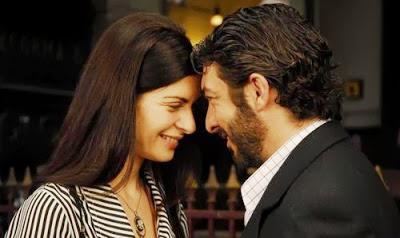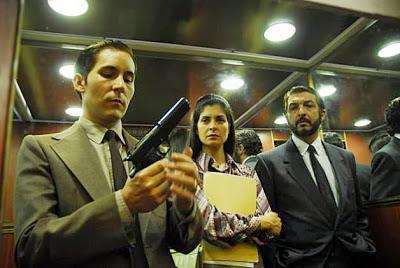 Viewers of this Oscar-winning Argentinean film are likely to enjoy the experience for varied reasons. It is definitely an engaging thriller with loads of subtle humor. It is therefore not surprising that the film was a commercial and critical success in the country of its origin, Argentina. The best foreign film Oscar, the second for Argentina over the years, bestowed on the film would have boosted its popularity at home even further. However, the film can be enjoyed by non-Argentinean audiences as well for several additional elements beyond the obvious thrilling tale the film unfolds.
Viewers of this Oscar-winning Argentinean film are likely to enjoy the experience for varied reasons. It is definitely an engaging thriller with loads of subtle humor. It is therefore not surprising that the film was a commercial and critical success in the country of its origin, Argentina. The best foreign film Oscar, the second for Argentina over the years, bestowed on the film would have boosted its popularity at home even further. However, the film can be enjoyed by non-Argentinean audiences as well for several additional elements beyond the obvious thrilling tale the film unfolds.The film is at a basic level a detective story of tracking down a rapist and killer and ensuring that he gets a fitting punishment for the crime. At a more complex level, it is a tale of love of two sets of couples and a strong camaraderie of two detective colleagues. And finally, the screenplay captures the mood of Argentina’s “dirty war” period from 1976 to 1983 (during which tale is set) when criminals held sway and at least 15000 social activists ‘disappeared’ and often social statusprovided a sense of security for a privileged few (such as the Cornell-educated Hastings in the movie) when compared to lesser mortals (such as the investigating officer Benjamin Esposito in the movie). The indirect connection to the "dirty war" is established briefly with the TV news item watched by three pivotal characters in the movie that shows Isabel Peron morphed with the rapist/killer as her bodyguard/security staff.The remarkable screenplay of the film, an adaptation of a book written by Eduardo Sacheri, is by both the author Sacheri and the film’s Argentinean director Juan José Campanella. The screenplay uses the power of cinema to elevate the tale of the book to an even more sophisticated level.Campanella, for those unfamiliar with his work, is an engaging and creative screenplay writer. For instance, Campanella’s 2001 film The Son of the Bride, another delightful Argentinean film that made the final nominee list for the best foreign film Oscar that year, had the lead character muttering away that he is “no Albert Einstein, a Bill Gates or a Dick Watson” making all viewers wonder who on earth was this Dick Watson. At the end of the film, when the end-credits are rolling, the movie humorously reveals that this mysterious Dick Watson is a character from a pornographic film. Campanella carries forward his unusual penchant for juggling non-chronologically images and incidents in The Secret in Their Eyes that add to a diligent viewer’s entertainment. For instance, the movie begins with shots of Judge Hasting’s and Investigator Esposito’s eyes and shots of the railway station in Buenos Aires which are only fleshed out much later halfway into the movie. Campanella is apparently reinforcing two important strands that continue throughout the duration of The Secret in Their Eyes: the importance of eyes so pivotal in the film and the development of the plot; and the importance of railway stations as a key location for both the two parallel love stories and the detective story in the film. And both deal with memories, something the script reminds us is “all that we end up with.”Campanella and Sacheri had devised a cute devise to capture the mood of Argentina to be weaved into the film. Judge Hastings (Soledad Villamil) hands Investigator Benjamin Esposito (Ricardo Darin) a typewriter which cannot type the alphabet “A”. Much later in the film the retired investigator Esposito, while writing a book on the case is shown waking up from a disturbed sleep and scribbling the word TEMO(‘I fear’). He knows and is afraid that he could be knocked off by the killer-cum-rapist who is out on the loose and is seeking revenge for being briefly arrested by him. Towards the end of the film, Esposito adds the alphabet “A” to TEMOto transform the scribble to TEAMO (‘I love you’). Campanella and Sacheri again prove the importance of a script that appears initially disconnected but is all tied up eventually.

Temo to Teamo: From 'Fear' to 'Love', with an alphabet added
Similarly, throughout the film Judge Hastings wonders if she ought to close the door of her office. The viewer would assume that it had something to do with the latent love affair between Hastings and Esposito that Hastings did not want her office staff to hear. But is it only that? It was a time when everybody seemed to be snooping on each other and the closing of doors became imperative for all important discussions. Take the sequence when Esposito and his dear colleague go snooping into a house of the suspect’s mother. The streets are empty. Yet there were people taking note of the car,its registration number, and what they were up to. The tale is set in a period when everyone was snooping on each other in Argentina.And later on, Esposito’s rival colleague berates Esposito in front of Hastings that he is a nobody on the social ladder, minutes before the spine chilling encounter in the lift with the rapist-cum-killer loading his gun to send a message to both Esposito and Hastings. It is a sign of the terror most Argentinians had encountered, irrespective of their social status, during the 'dirty war' years.
The message of terror in Argentina during the Dirty War years
Campanella is a delightful scriptwriter. He has proved it time and again with two marvelous films: The Son of the Bride and The Secret in Their Eyes. In both films, he was aided by the marvelous thespian Ricardo Darin, who exudes magnetic charm in each role, film after film. And Campanella has a magical touch with his actors Darin and Ms. Villamil not just in The Secret in Their Eyes but in an earlier work Same Love, Same Rain (1999). In all the three films, Campanella shows that he can elicit great performances from all his actors and he has a magic touch with script-writing. The viewers are not likely to forget the line “the gates of heaven have opened’’muttered by the males time and again as they encounter any beautiful woman in The Secret in Their Eyes.However, Sacheri and Campanella, through this film, have raised the issue of crime and punishment of rapist-killers worldwide. The punishment suggested by the filmmakers is thought-provoking. The contents of the film will make the viewer think about corruption and the consequences of lenient punishments accorded to such criminals.
But is Campanella the director, the best filmmaker to come out of Argentina in recent years? This critic considers the late Fabián Bielinsky, who made just two feature films The Aura (2005) and Nine Queens (2000) (both with Ricardo Darin in the lead roles), before he passed away prematurely in 2006 to be head and shoulders above Campanella as a director. The two Bielinsky films had a maturity that should make Argentinean cinema proud of raising the bar of quality though it is Campanella, who eventually brought home the Oscar statuette.P.S. The late Fabián Bielinsky’s The Aura was reviewed earlier on this blog.
<a href="http://feedjit.com/">Feedjit Live Website Statistics</a>

